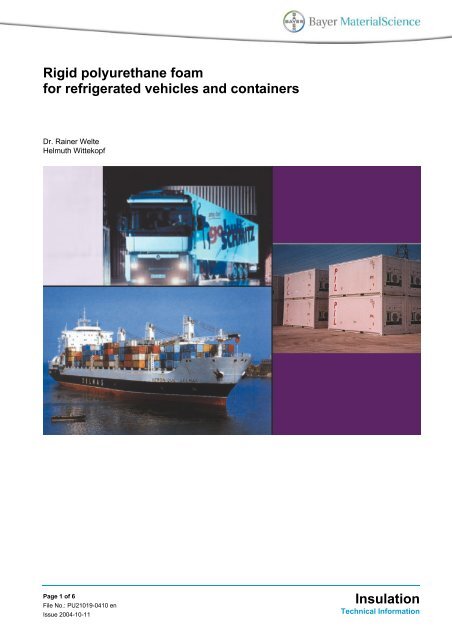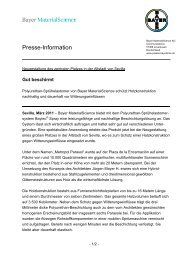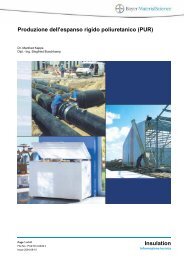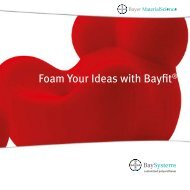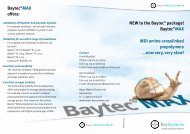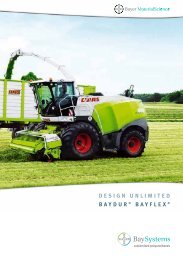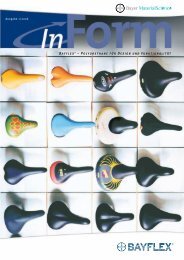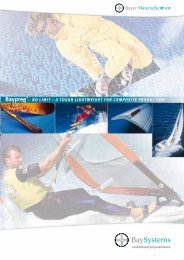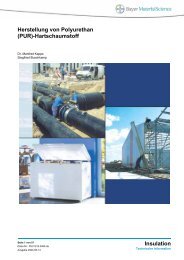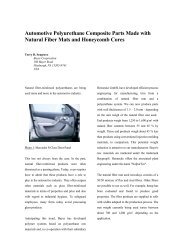Rigid polyurethane foam for refrigerated vehicles and containers
Rigid polyurethane foam for refrigerated vehicles and containers
Rigid polyurethane foam for refrigerated vehicles and containers
Create successful ePaper yourself
Turn your PDF publications into a flip-book with our unique Google optimized e-Paper software.
<strong>Rigid</strong> <strong>polyurethane</strong> <strong>foam</strong><br />
<strong>for</strong> <strong>refrigerated</strong> <strong>vehicles</strong> <strong>and</strong> <strong>containers</strong><br />
Dr. Rainer Welte<br />
Helmuth Wittekopf<br />
Page 1 of 6<br />
File No.: PU21019-0410 en<br />
Issue 2004-10-11<br />
Insulation<br />
Technical In<strong>for</strong>mation
<strong>Rigid</strong> <strong>polyurethane</strong> <strong>foam</strong><br />
<strong>for</strong> <strong>refrigerated</strong> <strong>vehicles</strong> <strong>and</strong><br />
<strong>containers</strong><br />
Summary<br />
Food <strong>and</strong> other highly perishable, temperaturesensitive<br />
merch<strong>and</strong>ise such as electronic devices,<br />
pharmaceuticals <strong>and</strong> fine chemicals are shipped or<br />
transported over l<strong>and</strong> in specially insulated <strong>containers</strong><br />
or <strong>refrigerated</strong> <strong>vehicles</strong>. Containers insulated<br />
with rigid <strong>polyurethane</strong> <strong>foam</strong> are used almost exclusively<br />
nowadays on account of the excellent properties<br />
of this material. Polyurethane is also being<br />
used more <strong>and</strong> more as a core material <strong>for</strong> s<strong>and</strong>wich<br />
panels <strong>for</strong> <strong>refrigerated</strong> <strong>vehicles</strong>.<br />
Contents<br />
Page 2 of 6<br />
File No.: PU21019-0410 en<br />
Issue 2004-10-11<br />
Page<br />
1. Perfect protection <strong>for</strong> 2<br />
sensitive goods<br />
2. Insulation <strong>for</strong> the most 4<br />
dem<strong>and</strong>ing applications<br />
3. New-generation blowing agents 5<br />
1. Perfect protection <strong>for</strong> sensitive<br />
goods<br />
Food <strong>and</strong> other highly perishable, temperaturesensitive<br />
merch<strong>and</strong>ise such as electronic devices,<br />
pharmaceuticals <strong>and</strong> fine chemicals are shipped or<br />
transported over l<strong>and</strong> in specially insulated <strong>containers</strong><br />
or <strong>refrigerated</strong> <strong>vehicles</strong>.<br />
To allow efficient transportation without damaging<br />
the merch<strong>and</strong>ise, refrigeration or freezing temperatures<br />
have to be kept constant even when external<br />
temperatures vary markedly, so features such as a<br />
high insulation value <strong>and</strong> hygiene are just as critical<br />
as light weight, a high loading capacity <strong>and</strong> ease of<br />
unloading. Containers insulated with rigid <strong>polyurethane</strong><br />
<strong>foam</strong> are used almost exclusively nowadays<br />
in international shipping on account of the excellent<br />
properties of this material. Polyurethane is also<br />
being used more <strong>and</strong> more as a core material <strong>for</strong><br />
s<strong>and</strong>wich panels <strong>for</strong> <strong>refrigerated</strong> <strong>vehicles</strong>. High<br />
mechanical strength, high insulating efficiency <strong>and</strong><br />
economical production are combined in this core<br />
material.<br />
Global <strong>refrigerated</strong> transport<br />
Polyurethane-insulated <strong>containers</strong> are transported<br />
on special container ships with a large loading capacity<br />
of up to 7,500 TEU (TEU st<strong>and</strong>s <strong>for</strong> 20 ft<br />
equivalent unit). At present, there are about<br />
800,000 <strong>refrigerated</strong> <strong>containers</strong> throughout the<br />
world, most of which are insulated with rigid <strong>polyurethane</strong><br />
<strong>foam</strong>.<br />
Refrigerated <strong>containers</strong> are invariably used <strong>for</strong><br />
shipping temperature-sensitive goods, while <strong>vehicles</strong><br />
with diverse <strong>refrigerated</strong> superstructures can<br />
be used in addition to actual <strong>containers</strong> <strong>for</strong> l<strong>and</strong><br />
transport. Semi-trailers up to 16 m in length are<br />
used <strong>for</strong> bulk transportation while smaller <strong>refrigerated</strong><br />
<strong>vehicles</strong> are involved in regional distribution.<br />
The increase in the number of <strong>refrigerated</strong> <strong>containers</strong><br />
<strong>and</strong> <strong>vehicles</strong> reflects the growth of international<br />
trade in highly perishable goods. Success in this<br />
growing sector of the transport industry relies on<br />
adaptation to different market requirements. Refrigerated<br />
vehicle manufacturers normally cater <strong>for</strong><br />
regional markets, whereas <strong>refrigerated</strong> <strong>containers</strong><br />
are produced <strong>and</strong> sold internationally.<br />
Insulation<br />
Technical In<strong>for</strong>mation
160<br />
140<br />
120<br />
100<br />
80<br />
60<br />
40<br />
20<br />
Page 3 of 6<br />
File No.: PU21019-0410 en<br />
Issue 2004-10-11<br />
0<br />
1991 1992 1993 1994 1995 1996 1997 1998 1999 2000 2001 2002 2003 2004 2005 2006<br />
Production of reefer <strong>containers</strong> 1991 - 2006 (2004 - 2006 predicted, in 1,000 TEU)<br />
Bayer MaterialScience AG is a powerful ally <strong>for</strong><br />
manufacturers as it is represented internationally in<br />
the <strong>polyurethane</strong>s sector. By no means all other<br />
manufacturers of <strong>polyurethane</strong> raw materials <strong>for</strong><br />
1400<br />
1200<br />
1000<br />
800<br />
600<br />
400<br />
200<br />
0<br />
<strong>refrigerated</strong> transport have the expertise which<br />
Bayer has gained through its extensive knowledge<br />
of international <strong>and</strong> national market trends.<br />
1991 1992 1993 1994 1995 1996 1997 1998 1999 2000 2001 2002 2003 2004 2005 2006<br />
Worldwide reefer container fleet (2004 - 2006 predicted, in 1,000 TEU)<br />
Insulation<br />
Technical In<strong>for</strong>mation
2. Insulation <strong>for</strong> the most dem<strong>and</strong>ing<br />
applications<br />
Refrigerated <strong>containers</strong> <strong>and</strong> <strong>vehicles</strong> are generally<br />
run under conditions which dem<strong>and</strong> both optimum<br />
thermal insulation <strong>and</strong> high mechanical strength.<br />
These properties have to be maintained throughout<br />
the service life of the product, which often exceeds<br />
15 years. The specific requirements of shipping<br />
lines, leasing companies, etc., which result from a<br />
number of different influences, are also an important<br />
factor <strong>and</strong> include:<br />
• type of freight transported<br />
• loading <strong>and</strong> unloading conditions<br />
• quality of h<strong>and</strong>ling in different areas<br />
• requirements of the International St<strong>and</strong>ards<br />
Organization (ISO regulations)<br />
• personal preferences <strong>and</strong> company policy<br />
• national transport legislation.<br />
In addition, production costs, durability, corrosion<br />
resistance, low repair <strong>and</strong> maintenance costs (lifecycle<br />
costs) have to be taken into consideration<br />
when producing <strong>refrigerated</strong> <strong>containers</strong> <strong>and</strong> <strong>vehicles</strong>.<br />
Bayer MaterialScience AG works in close cooperation<br />
with its customers here: all our <strong>polyurethane</strong><br />
raw materials are subjected to a lengthy internal<br />
quality assurance procedure in compliance<br />
with strict DIN EN ISO 9001/2000 st<strong>and</strong>ards.<br />
A typical <strong>refrigerated</strong> container<br />
Page 4 of 6<br />
File No.: PU21019-0410 en<br />
Issue 2004-10-11<br />
Rein<strong>for</strong>cing s<strong>and</strong>wich panels<br />
The design of the frame, the floor <strong>and</strong> the roof of<br />
insulated <strong>containers</strong> <strong>and</strong> <strong>vehicles</strong> is critical, the<br />
strength of the structure being dependent on the<br />
mechanical properties of the rein<strong>for</strong>cing s<strong>and</strong>wich<br />
panels. These panels consist of a rigid <strong>polyurethane</strong><br />
<strong>foam</strong> core with metal facings which are<br />
bonded over the entire surface of the <strong>polyurethane</strong><br />
core layer to strengthen the container. The constant<br />
vibrations <strong>and</strong> shocks encountered during road<br />
transportation make long-term stability an essential<br />
requirement, <strong>and</strong> one which the elasticity of the<br />
rigid <strong>polyurethane</strong> <strong>foam</strong> satisfies.<br />
In addition to the mechanical requirements, the<br />
original high insulation value of the rigid <strong>polyurethane</strong><br />
<strong>foam</strong> has to be maintained over long periods<br />
to avoid aging. This is achieved by using facings<br />
which prevent the diffusion of water even at internal<br />
temperatures below - 25 °C. The insulation thickness<br />
ranges from 50 to 200 mm at densities of between<br />
45 <strong>and</strong> 100 kg/m³. However, if internal temperatures<br />
are only 0 °C to 5 °C, thinner insulating<br />
layers down to a minimum of 20 mm are used.<br />
The facings can consist of aluminum, steel,<br />
stainless steel or glass fiber rein<strong>for</strong>ced plastics<br />
laminates <strong>and</strong> are from 0.4 to 2.0 mm thick. The<br />
s<strong>and</strong>wich panels are produced in lengths of 3 to<br />
16 m using specially designed temperaturecontrolled<br />
<strong>foam</strong> presses <strong>and</strong> are either welded or<br />
riveted to the frame, depending on the materials<br />
used <strong>and</strong> the frame construction.<br />
Insulation<br />
Technical In<strong>for</strong>mation
Cavities remaining after the panels have been fixed<br />
are filled with <strong>foam</strong> to provide uni<strong>for</strong>m insulation<br />
with excellent physical properties. About 300 kg of<br />
rigid <strong>polyurethane</strong> <strong>foam</strong> are required to insulate a<br />
st<strong>and</strong>ard <strong>refrigerated</strong> container. The <strong>for</strong>mulations<br />
used <strong>and</strong> the methods of production have been<br />
continuously developed <strong>and</strong> improved in recent<br />
years. This guarantees that the <strong>polyurethane</strong> s<strong>and</strong>wich<br />
panels produced have uni<strong>for</strong>mly high strength<br />
<strong>and</strong> elasticity as well as optimum insulating values.<br />
3. New-generation blowing agents<br />
Up until the end of 2003, the use of the HCFCbased<br />
blowing agent R141b in the production of<br />
rigid <strong>polyurethane</strong> <strong>foam</strong> in the transport sector was<br />
still sanctioned under the Kyoto Protocol. Nowadays,<br />
however, blowing agents having a GWP<br />
(global warming potential) > 0 must be used. New<br />
<strong>foam</strong> systems based on alternative blowing agents<br />
have accordingly been developed.<br />
The most promising alternatives<br />
Since the early 1990s, Bayer has been researching<br />
new R11-free <strong>polyurethane</strong> <strong>foam</strong>s to replace the<br />
<strong>for</strong>mer systems. Numerous chemical <strong>and</strong> physical<br />
tests yielded three alternative <strong>foam</strong> systems with<br />
the blowing agents R141b, cyclopentane <strong>and</strong> carbon<br />
dioxide. The Kyoto Protocol states that an alternative<br />
must now also be found <strong>for</strong> the blowing<br />
agent R141b. Meanwhile, cyclopentane, isopentane,<br />
n-pentane <strong>and</strong> mixtures of these have<br />
enjoyed much success with European <strong>polyurethane</strong><br />
manufacturers, <strong>and</strong> there is also the new generation<br />
of HFC blowing agents, 365mfc <strong>and</strong> 245fa.<br />
The mechanical properties of all the <strong>foam</strong>s tested<br />
easily surpassed the minimum requirements <strong>for</strong><br />
such applications. The production parameters could<br />
also largely be adapted to previous values, resulting<br />
in minimal production changes.<br />
Proven insulation efficiency<br />
The insulation value of rigid <strong>polyurethane</strong> <strong>foam</strong> is<br />
also important in <strong>refrigerated</strong> <strong>containers</strong>. The heat<br />
transmission capacity of an insulated container, that<br />
is the total energy required to maintain a constant<br />
internal temperature against defined external temperatures,<br />
determines the power requirement of the<br />
refrigerating unit.<br />
Page 5 of 6<br />
File No.: PU21019-0410 en<br />
Issue 2004-10-11<br />
Heat losses through rigid <strong>polyurethane</strong> <strong>foam</strong> can be<br />
calculated purely theoretically on the basis of its<br />
γ value. On the other h<strong>and</strong>, data relating to the<br />
complete container can only be determined by testing<br />
the finished article.<br />
The thermal properties of the rigid <strong>polyurethane</strong><br />
<strong>foam</strong> as well as any thermal bridges resulting from<br />
structure-related factors or insufficient integrity are<br />
critical. These parameters were investigated by<br />
subjecting a batch of 20 <strong>containers</strong> to 12-hour tests<br />
in a refrigeration chamber with substantially constant<br />
temperature variations <strong>and</strong> air speeds, to determine<br />
heat transmission. Each type of container<br />
was examined by measuring five identical <strong>containers</strong><br />
in succession to provide statistically accurate<br />
results.<br />
Test results<br />
When measured, the diathermancy of the HFC<br />
blowing agents 245fa <strong>and</strong> 365mfc/227ea 94/6 was<br />
approx. 9.5 % higher than that of R141b.<br />
The insulating effect of the <strong>foam</strong>s blown by the representatives<br />
of the pentane family was reduced by<br />
approx. 8 % in the case of cyclopentane, approx.<br />
11 % in the case of 70/30 cyclopentane/isopentane,<br />
<strong>and</strong> approx. 14 % in the case of iso-pentane <strong>and</strong> npentane,<br />
compared with R141b-blown <strong>foam</strong>.<br />
Cyclopentane or the 70/30 c/i-pentane mixture currently<br />
looks set to establish itself in Europe as the<br />
norm <strong>for</strong> large-scale production. The 94/6 HFC<br />
365mfc/227ea mixture will <strong>for</strong> the time being retain<br />
its place in the market as an alternative <strong>for</strong> smallscale<br />
or specialized production. Bayer Material-<br />
Science AG has fully-developed systems to cover<br />
all of these developments. The loss in insulating<br />
efficiency compared to HCFC R141b will, however,<br />
have to be compensated by an increase in insulation<br />
thicknesses <strong>and</strong> possibly by improved construction<br />
<strong>and</strong> refrigeration units.<br />
Insulation<br />
Technical In<strong>for</strong>mation
This in<strong>for</strong>mation <strong>and</strong> our technical advice – whether verbal, in writing or by way of trials – are given in good faith but without warranty, <strong>and</strong><br />
this also applies where proprietary rights of third parties are involved. Our advice does not release you from the obligation to verify the in<strong>for</strong>mation<br />
currently provided - especially that contained in our safety data <strong>and</strong> technical in<strong>for</strong>mation sheets - <strong>and</strong> to test our products as to<br />
their suitability <strong>for</strong> the intended processes <strong>and</strong> uses. The application, use <strong>and</strong> processing of our products <strong>and</strong> the products manufactured by<br />
you on the basis of our technical advice are beyond our control <strong>and</strong>, there<strong>for</strong>e, entirely your own responsibility. Our products are sold in<br />
accordance with the current version of our General Conditions of Sale <strong>and</strong> Delivery.<br />
The methods described in this publication <strong>for</strong> testing the fire per<strong>for</strong>mance of <strong>polyurethane</strong>‚ <strong>and</strong> the results quoted‚ do not permit direct conclusions<br />
to be drawn regarding every possible fire risk there may be under service conditions.<br />
Publisher: Business Development – Insulation<br />
Bayer MaterialScience AG,<br />
D-51368 Leverkusen<br />
www.bayermaterialscience.com<br />
Page 6 of 6<br />
File No.: PU21019-0410 en<br />
Issue 2004-10-11<br />
Insulation<br />
Technical In<strong>for</strong>mation


